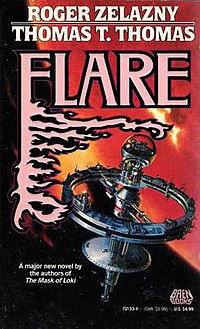 Cover illustration from the first edition | |
| Author | Roger Zelazny and Thomas Thurston Thomas |
|---|---|
| Cover artist | Dean Morrissey |
| Language | English |
| Genre | Science fiction |
| Publisher | Baen Books |
Publication date | September 1992 |
| Publication place | United States |
| Media type | Print (paperback) |
| Pages | 344 |
| ISBN | 0-671-72133-X |
| OCLC | 26429687 |
Flare is a science fiction novel by American writers Roger Zelazny and Thomas Thurston Thomas, published in 1992.
The novel envisions Earth in the year 2081 and explores the harmful impact that a solar flare could have on a future interplanetary civilization after nearly a century of solar inactivity.
The book takes a scientific approach to its concept, offering almost no traditional narrative. Instead, it is composed of short segments depicting people in various locations suffering from the effects of the solar flare.